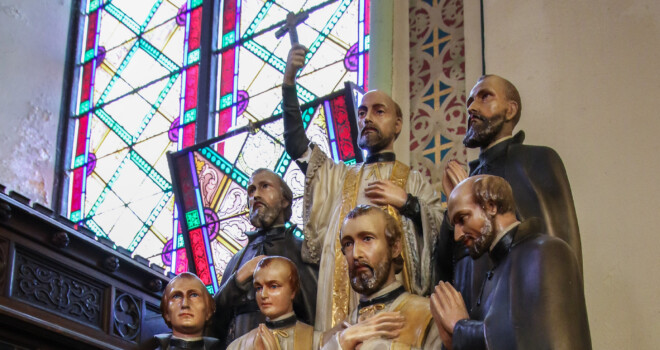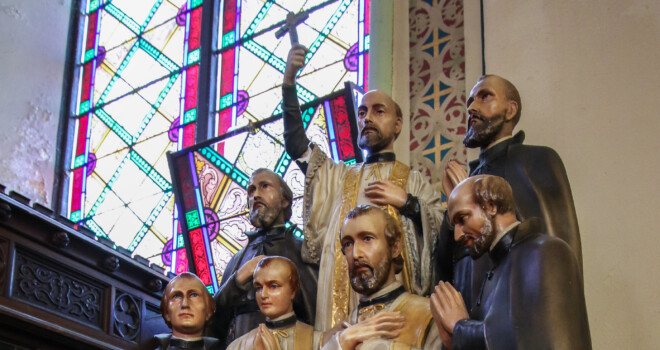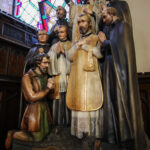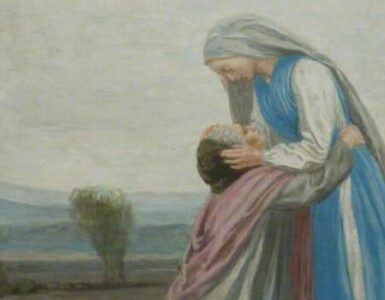(Sermon 49 from Selected Sermons of Thomas Aquinas McGovern, S.J.)
For the past few years, October 19 – which, of course, is today – has been in the Church the feast day of the North American Martyrs. For decades previous this same feast had been celebrated on September 26, a day of no small solemnity in Jesuit houses. When the date was changed, this came as something of a wrench, like changing the feast of St. Thomas from March 7 to January 28. It strikes us as almost a violation of the natural law.
The Collect prayer of yesterday’s Mass mentions the North American martyrs simply as Isaac, John, and their companions, or if you happen to be in Canada, then John, Isaac, and their companions. The liturgy makes no mention, as it has no reason to, that they were French by birth and nationality; that they were eight in number, that six were Jesuit priests and the other two, at the time of their deaths, brothers in this same least Society.
The Collect prayer mentions North America as the place where these saints labored and died. It defines the locale no more precisely than that. Actually, what is now central New York State was the site of Father Jogues’ labors and death, his and the two Brothers René Goupil and John Lalande. The western sector of the present Canadian province of Ontario, along the eastern shore of Lake Huron around the present town of Midland, is where Brébeuf and Lalemant, Daniel, Garnier, and Chabanel labored and died.
In New York State, about forty miles west of the state capital, along the south bank of the Mohawk River in the wide valley that divides the Catskill mountains to the south from the Adirondacks to the north, is the small village, not much more than a post office, of Auriesville. A few miles to the east, sloping upward from the south bank of the river, are several acres that the Jesuits have owned now for many decades. They call it the Auriesville Shrine, and it is a pilgrimage center for Catholics of the Northeast. The Jesuits built a shrine there, a large dodecahedron with seventy-two doors, a bit of a monstrosity in fact. But it really doesn’t matter much. It is not the building that sanctifies that portion of real estate; what Father Jogues suffered and did there hallowed that spot far beyond the power of future generations to add or subtract.
One walks the paths among the trees there even today and one has the sense of being in a sanctuary or walking on sacred ground, ground hallowed some three hundred and forty years ago by the priest who spent thirteen months there as a captive of the Mohawk Indians, literally a slave of the savages. It is ground sanctified, more precisely, by the patience and privation there, by the quiet persistent energy with which he went about doing what he could for the salvation of souls, by the love of Our Lord and Savior Jesus Christ, which motivated it all.
Father Jogues was brought in bonds to that spot on the Mohawk, a captive of the Indians after whom the stream is named. A war party took him in ambush far to the north, in the French country along the St. Lawrence, and brought him to their homeland. There was one with him named René Goupil, whom Father Jogues received into the Society of Jesus as a brother, and who died soon after at Auriesville of a hatchet blow. Goupil was the first of the martyrs.
Father Jogues was enslaved there along the Mohawk, suffered there, did what he could there, baptizing the dying, for thirteen months. With the help of the Dutch at Albany, he escaped and returned to France. He received permission from Pope Urban to say Mass with what was left of his mangled hands, and at his own request returned to the missions in New France.
The Iroquois were seeking peace now, or at least pretended to be, with the French and all things French. They would welcome Father Jogues back among them as a goodwill ambassador. With misgivings, but moved by hope of some missionary success, he begged to be allowed to return to the site of his former agonies. For the second time, but now of his own free choice, he took his place in the Iroquois canoe and headed toward Mohawk. Again there was a brother with him – John Lalande. That was in July 1646.
The Iroquois change of heart proved to be not much more than another instance of savage treachery, and on October 18 of that year, a blow of a tomahawk sent him home. The following day John Lalande met the same fate.
To the extent that we acquire any familiarity with the lives of the martyrs, we live in admiration of their incredible patience and fortitude; their unbelievable endurance in the midst of the filth and squalor in diet and abode; the undisguised and unconcealed immorality and the insensitivity and unspeakable brutality of man to man in which they took it upon themselves to live. They reported it all to their superiors back home, as they were bidden to do. In the hundreds of pages of the Jesuit Relations there are many requests for prayerful assistance but never a whimper, never a complaint. In all their writings there shines forth the portrait of the most beautiful things under heaven – utterly unselfish men.
In the accomplishment of their own work they were pros. They knew what they were about. Along Georgian Bay, among the more receptive Hurons, they worked with no small success. They learned the dialects and compiled dictionaries. They taught the savages to read and taught them the rudiments of healthy living. They improved the farming methods and increased their vocabularies so they could be instructed about the Trinity and the Incarnation, the fall, and grace and the sacraments. They made solid converts in every-increasing numbers. Gradually their stockade villages became kernels of Christian civilization, with Church and school at the center.
Over it all there hung an air of impermanence and the near certainty of ultimate failure because of the ever-present threat from the south. For the Iroquois, their war against the Hurons was a war of extermination. When the trails became passable in the spring, the war parties headed north, and the Hurons were no match for them. The Jesuits in Huronia were too well aware of the kind of end that awaited them – it was just a question of time.
The final destruction both of themselves and their work came in 1648 and 1649. For some, death was mercifully swift. Father Daniel fell in a shower of arrows, Chabanel and Garnier took blows of the hatchet. But John de Brébeuf and Gabriel Lalemant were captured together. Brébeuf was five hours at the sake. Lalemant’s turn followed, and the savages prolonged his agony from sunset to sunrise. The two men endured every pain that knife and flame and boiling water can inflict, but in the end they conquered their conquerors, for there was never a whimper or a scream on the lips of either, only the prayer of Christ: “Father, forgive them.”
“O God, who have consecrated the first fruits of North America by the preaching and the blood of Isaac and John and their companions,” we pray in the Collect prayer of the Mass. The history of this country and Canada was sanctified, consecrated, and hallowed at its source by the sufferings and deaths, successes and failures, of eight very good men. After this introduction in the opening prayer, the Church makes its petition – a petition for the continuation on earth of that work to which they dedicated their lives. “Grant that through their intercession the flowering harvest of Christians may be increased every day and everywhere.”
Links:
Click here for Selected Sermons of Thomas Aquinas McGovern.
image: North American Martyrs in the church of Our Lady of the Assumption in Windsor, Ontario / Fr. Lawrence Lew, O.P. / Flickr (CC BY-NC-ND 2.0).















